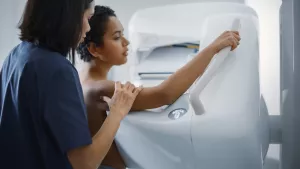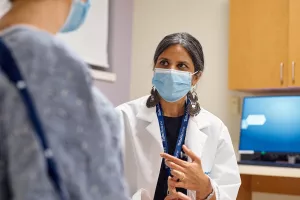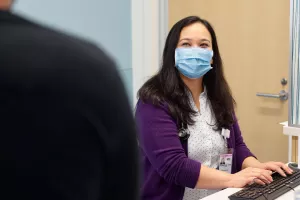When your breast health needs are anything but average, we’re here to over-deliver — from preventative screenings and risk assessments to plastic surgery and chemotherapy.
Supporting your best health with breast health
Many innovations designed to support breast care have rolled out in recent years. The evolution of 2D mammograms to 3D mammograms (also known as tomosynthesis) covers the breasts from all angles, allowing doctors to detect breast lumps hidden by overlapping breast tissue that may have gone undiscovered before.
For people living with breast cancer, we offer oncoplastic breast surgery, a “2-for-1” procedure where we remove a tumor and reconstruct the breast at the same time.
But one thing that hasn’t changed is our belief that everyone deserves breast care tailored to their needs. You can count on us to be there for you every step of the way, from regular checkups and screenings to treatments and ongoing care.

Conditions
Tufts Medicine is your home for compassionate, comprehensive breast care. We treat the full range of benign and cancerous breast conditions, including:
Testing
Your care team will suggest age-appropriate tests to track your breast health.
According to breastcancer.org and the CDC, about 5–10% of breast cancers are thought to be caused by genes passed from parent to child, also known as hereditary conditions. Your doctor will account for your personal and family health history when ordering different tests to better understand your health, like:
- Breast biopsies (stereotactic and ultrasound-guided biopsies)
- Breast cyst and fine-needle aspirations
- Breast MRI
- Breast ultrasound
- Galactography (ductography)
- Mammogram (diagnostic mammography and 3D breast tomosynthesis screening mammography)
- Needle localization
- Breast cancer risk assessments and genetic testing
- Sentinel node studies
Breast MRI
Magnetic resonance imaging (MRI) is an imaging test that uses a strong magnetic field and radio waves to take pictures of the inside of your body.
Your doctor may recommend a breast MRI to:
- Compare scar tissue following breast cancer surgery
- Evaluate breast implants and the surrounding tissues to check for infections or other abnormalities
- Examine the breasts of a person who’s newly diagnosed with breast cancer prior to any surgery
- Get a closer look at abnormalities found during a physical exam, mammography or ultrasound
- Track the effectiveness of chemotherapy treatment for people living with breast cancer
Breast ultrasound
If we find something abnormal or suspicious in a mammogram or another imaging test, we may follow up with a breast ultrasound to pinpoint a diagnosis.
A breast ultrasound only takes about 20 minutes to complete. During this exam, a sonographer scans the breast area using sound waves to produce images that our radiology team analyzes.
Mammogram
At Tufts Medicine, we use the latest in mammogram technology to help keep your breast health a part of your best health. That includes 3D mammography (tomosynthesis), which allows us to see the breast in greater detail than traditional 2D mammograms.
The American Cancer Society recommends that women and individuals assigned females at birth (AFABs) start an annual mammogram routine at age 40. Why 40? Because the risk of developing breast cancer substantially increases around this age. The breast cancer occurrence rate for women in their 40s is up to 3 times higher than it is for women in their 30s.
That's why we strongly encourage people to take the lead on their health and receive a routine mammogram.
Treatments
Once we've diagnosed your condition or have a better understanding of the type of care you'll need, we'll design a treatment plan that's uniquely you. We may recommend the following treatments, ranging from lifestyle changes to medication to surgery:
- Biotherapy
- Breast surgery
- Chemotherapy
- Complementary and holistic medicine
- Immunotherapy
- Infusion services
- Oral oncolytics
- Plastic surgery
- Radiation therapy
Breast surgery
We use the latest advancements in breast surgery to treat breast cancer and a variety of benign (noncancerous) breast conditions. Our goal is to help you get your life back on track and stay tumor-free.
One of those advancements is oncoplastic breast surgery, a "2-for-1" procedure where we remove a tumor and reconstruct the breast at the same time. Achieving these 2 goals at the same time means you'll require fewer surgeries and benefit from shorter recovery times.
Based on our patient history, 90% of people are cancer-free at the margins following oncoplastic surgery. Plus, you'll walk out our doors feeling comfortable and confident in how you look.
It takes a special skill set to complete an oncoplasty, and only 20 or so physicians in the country are certified to perform it — including doctors at Tufts Medicine.
Breast health support team
Learning that you have or may have breast cancer can bring on a wave of emotions, so we're here to help you navigate these new waters. When you're under our care, you'll be paired with a dedicated nurse who's specially trained to support you in all aspects of breast cancer care, including:
- Connecting people who are at high risk for developing breast cancer with genetic counseling services
- Helping you understand test results
- Keeping track of your health history
- Providing clinical breast exams as appropriate
- Working with your care team to schedule tests and other appointments
Support groups
You should never feel alone or unsupported while living with breast cancer. Breast cancer support groups are a safe space to share feelings, fears, strength and hope with people who understand firsthand what you've experienced.
FAQs
About 1 in 8 women and individuals assigned females at birth (AFABs) will develop breast cancer during their lifetime.
About 1 in 1,000 men and individuals assigned males at birth (AMABs) will develop breast cancer during their lifetime.
If you notice anything unusual about your breasts, contact your medical provider right away. The American College of Radiology recommends starting annual mammography screening at age 40 for women of average risk of developing breast cancer.

From regular office visits to inpatient stays, find the healthcare you need and deserve close to home.

Meet the doctors and care team devoted to supporting you every step of the way along your path to better health.